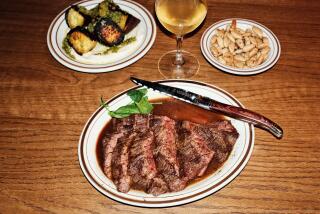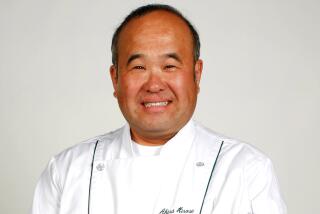RESTAURANTS : KAPPO KYARA: A SUSHI-FREE JAPANESE RESTAURANT
- Share via
I keep having to remind my friends that there’s more to Japanese cuisine than just raw fish. From time to time I’ll invite someone to a Japanese dinner at a new place I consider an exciting discovery, and more often than not they’ll reply, “I don’t really feel like sushi tonight.”
Now why do they always say that? The Japanese don’t eat sushi for dinner. In fact, at Kappo Kyara, an engaging little restaurant in the monolithic new Little Tokyo Square, they don’t even serve sushi. Everything that comes out of this innovative kitchen is fully cooked except the pickles. That’s the way it’s going to stay too.
Kappo Kyara is the proverbial hole-in-the-wall, a bread basket-sized restaurant that’s almost always crowded, and that would seem crowded even if you were the only customer. During the week the overwhelmingly Japanese clientele consists of thirsty businessmen who eat and drink with endless stamina, but on weekends it runs to families and young couples. They all come to enjoy chef Kozo Terajima’s kappo cuisine, little dishes created to accompany sake and beer. Nobody eats just one; no matter who is involved, this is pagan eating at its most refined.
Kappo originated in Japan’s Kansai, the region encompassing the great cities Osaka, Kyoto, and Kobe. Food in this region is saltier and heartier than in Tokyo, and some dishes really show imagination. That’s because it’s one of the few forms of Japanese cooking that has not been formalized. The result is pure delight.
You might begin by trying a specialty I haven’t encountered anywhere, yuba chakin, made from yuba, tissue-thin translucent sheets skimmed from the surface of heated soy milk. In Japan, for some peculiar reason, yuba is eaten only in Kyoto. Kappo Kyara wraps finely minced crab and whitefish in the sheets and then steams the tiny bundles in a bamboo basket, producing what must be the most ethereally delicious appetizer in Los Angeles. The experience is fleeting, but your sense memory will long be dazzled.
Another wonderful dish is the agedashi dofu, a ceramic dish containing dashi, a flavorful broth of chicken stock and meat, slippery little nameko mushrooms, a flat, sea-green tangle of konbu (intensely flavored seaweed) and the piece de resistance, a large cube of silken lightly breaded tofu. The dish is part liquid, part solid, and all pleasure. One spoonful should convince you.
Not everything here is so ephemeral, but even more ordinary items are treated with delicacy. Beef is served teriyaki-style in a thick sauce, or salt-broiled, and served on a sizzling platter (shio-yaki). You don’t get much but what you get is perfect, thin slices looking for all the world like a bonsai version of Chateaubriand, without the superfluous bearnaise. The vegetarian in our group was actually tempted by its perfection, but cooler heads and faster chopsticks prevailed.
Various fishes, filleted, deep-fried or blanketed in light Japanese sauces are given imperial treatment. Buri, or yellowtail, a Japanese favorite, is especially delicious here when broiled; it is also the fish used in the most common form of Japanese teriyaki. Karei, or sole, is fried to a golden curl. It’s hard to lose your way on this menu.
If you’re still not sure, there are other curiosities. Soboro manjyu is a yam cake with minced chicken inside, a golden ball in a clear, thick sauce. Kisetsu-yasai-ni is steamed clams with seasonal vegetables, now featuring shintorina, a Kyoto vegetable resembling Napa cabbage, but with a spicier flavor. Still another is pork shunkan-ni, a hefty cube of roasted pork in a broth surrounded by sprigs of mitsuba, an aromatic grass. It’s exotic and intoxicating.
One of the good things about Kappo Kyara is that most of the best dishes on the menu are written in English. There is an additional hand-written Japanese menu that changes monthly, but it doesn’t appear to be fear of displeasure or embarrassment which keep them from doing a translation, just the lack of a good dictionary. Don’t despair. The manager, Mr. Naito, will be glad to help you with it, and failing that you can certainly point. The staff is extremely accommodating.
If the restaurant has any flaw, it is in the size of the portions in relation to the price. You can easily run up the bill before you feel sated, and because many business clients enjoy an expense account, the restaurant doesn’t pay much attention to quantity. It also goes against the grain of the Japanese aesthetic to serve giant platters of food. I say they could make the dishes a little bigger. If they were any smaller, it would almost be like going out for sushi.
Kappo Kyara, 330 S. Alameda St., Los Angeles, (213) 626-5760. Open Monday-Saturday 11:30 a.m.-2:00 p.m. and 5:30-10:30 p.m. Beer and wine. Validated parking in Little Tokyo Square. Visa, MasterCard, American Express accepted. Dinner for 2 (food only) $25-$50.
More to Read
Eat your way across L.A.
Get our weekly Tasting Notes newsletter for reviews, news and more.
You may occasionally receive promotional content from the Los Angeles Times.










